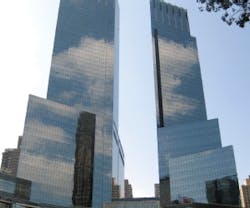For your sustainability practices to truly take flight, it’s not enough to green the inside of your building. Your facility impacts the rest of the site surrounding it – and it may be dangerous to local wildlife.
Glass buildings are beautiful and provide occupants with much-needed daylight, but to birds, they frequently appear as uninterrupted sky. Colliding with glass is the biggest known killer of birds in the United States and is responsible for hundreds of millions of deaths every year, according to the American Bird Conservancy. In addition to the environmental impact, the sight and sound of birds slamming into windows are distressing for the occupants who witness the phenomenon.
Green practices can’t stop at your doorstep. Read on to discover how to make your building bird-friendly.
Is Your Building Dangerous for Birds?
Migratory songbirds such as sparrows, thrushes, and warblers are typically the most vulnerable, especially during migration periods in spring and fall, explains Christine Sheppard, bird collision campaign manager for the American Bird Conservancy. Birds typically feed on insects, some of which can transmit disease or damage trees if there are fewer birds to control their population.
3 Tactics That Don’t Work
1) Small Frits
Examine potential frit patterns from a distance. How well can you make out the dots? If you have a hard time distinguishing between them, it will be even harder for birds, who may perceive the dots as small clouds on the horizon. Ideal frits are prominent and arranged into patterns, such as stripes or larger shapes, to drive home the point that your window is not sky.
2) Indoor Patterns
Films or tapes attached to the inside of your glass may not ameliorate the whole problem because the outside of the windows is still reflective. Depending on the angle, birds may not see your film at all thanks to the reflection on the outside. The best films and tapes attach to the outside to help break up the glare.
3) Silhouettes
Giant patterns of hawks and owls (such as the one at right) are popular choices because many people believe smaller songbirds will fear the predators, but this is rarely the case, Sheppard notes: “Birds don’t recognize silhouettes as dangerous. They just recognize it as something they can fly around.” If you’re sold on window films, Bates recommends working with an architect to design a film that mimics frit patterns.
Unfortunately, some of the same features commonly used to create sustainable buildings that are healthy for occupants can be deadly to birds – namely, the increasingly popular expanses of glass. Glass presents a two-pronged problem: depending on how reflective it is, it can appear as either a transparent view into your indoor plantings or as a reflection of the sky and outside vegetation. In both cases, birds simply perceive it as space they can fly through.
Nearby vegetation exacerbates the problem. Birds are drawn in when they look for places to roost or feed, but they become confused when they see the same trees or plantings reflected by glass and may collide with the window attempting to forage in the plants they think they’re seeing. Try taking a look around your property to find potential trouble spots.
“Look at all of the types of habitat provision that might be happening,” says Roderick Bates, an associate and LEED AP with KieranTimberlake, a Philadelphia-based architecture, research, and planning firm. “Do you have plantings that provide berries and are fruiting during certain times of year? Do you have water features? How big are your ledges or parapets?”
Light is also a powerful draw for birds, especially if your area is foggy or overcast at night, when migration typically takes place. Intense light projected into the sky refracts and disorients the birds, who can literally become trapped in the skyward beams. Buildings that are lit all night also contribute to the phenomenon.
“They’re drawn to the beams of light like moths,” explains Deborah Laurel, principal for Prendergast Laurel Architects. “In places like New York where a lot of lights shine all night, birds are attracted and get exhausted. They end up on the ground or find a tree to perch on for a while. When dawn arrives, they’re in the middle of a glass canyon, which is disorienting. They forage for some sustenance to keep going, but when it’s bright and sunny, the reflections of trees and the sky are more intense on any kind of glass surface and they’re prone to be caught on the glass when they try to navigate.”
Try Temporary Solutions
First, narrow down which areas of glass tend to attract the most bird strikes. More than likely, you won’t have to find fixes for every window – one face or even just a few panes could be responsible, Laurel says. Start with complaints and anecdotal evidence from occupants to narrow down which areas of your building are causing the most casualties.
Next, look at your budget. You probably can’t replace the glass in the biggest problem areas – at least, not right away – so you may need to turn to short-term solutions to cut down on bird strikes while you figure out how to tackle the problem in the long term.
Tempera paint: This art class mainstay can buy you some time until you’re able to identify something more permanent. The idea is to break up the large swaths of clear glass so birds can see that there’s an obstruction in their flight path. Try painting squiggles, strips, or dots – just make sure they’re about 4 inches apart vertically, Laurel recommends.
Tapes: If you’re really in a pinch, painter’s tape will serve the same basic purpose as tempera paint. A more durable solution is found in specialized bird tapes – translucent blue-green strips that stick to the outside of the window. Outdoor-approved vinyl adhesive tapes can also work, Laurel explains.
“In Toronto, Cadillac Fairview used a vinyl tape with a dot pattern,” says Laurel. “All the installer did was put it in place, press it down, and peel away the backing. Immediately, the reduction in collisions was huge. It was like an instant solution.”
Films, coatings, and tints: There are plenty of solutions on the market designed to last for several years before they have to be replaced, such as transparent films with striking patterns. Morgan Mail, a Manhattan mail distribution center, opted to install a vinyl signage product after they realized their black spandrel windows were reflecting a nearby park and leading to a relatively high number of bird strikes. Assisted by New York City Audubon, the facility installed a black film over the windows that lets light into the building but isn’t reflective.
“It’s like the perforated film on the sides of buses that ads are printed on,” Laurel explains. “Because it had a matte finish, the problem was solved.”
When Fast Fixes Aren’t Good Enough
If temporary solutions aren’t cutting it, it may be time to scale up your efforts into something more permanent. Consider these four strategies.
Blinds: Venetian blinds, vertical louvers, or other indoor solutions are not only bird-safe, they also let occupants scale down the brightness in their workspaces if it’s too bright outside. Laurel recommends keeping them half-open as much as possible, particularly in the daytime and especially during migration.
Etching and frits: When choosing permanently applied patterns for glass, try to look at it from a bird’s point of view. Birds have worse contrast sensitivity than people, so a simple dotted pattern may not do the job. However, arranging those dots into rows with the same amount of coverage can be highly effective.
One Toronto building surrounded by a laminated glass windbreak replaced its problematic clear glass with an acid-etched version featuring a deco pattern, says Sheppard, while a Novartis office building in New Jersey opted for a variety of bird-friendly glass.
“Novartis uses a mix of different types of glass – etched, clear, and fritted – all mixed into an artistic palette,” Laurel says. “Even though it’s an all-glass building, only about one-third of the glass is clear, so the risk is lowered substantially.”
Other patterns: The Bronx Zoo is currently testing a window with embedded UV stripes, Laurel says. Birds can see in the ultraviolet range, but because humans have a more limited range of color perception, the UV pattern is relatively unobtrusive. Product testing for UV glass and films is now focusing on which patterns are best at deterring birds while requiring the least amount of window coverage.
Netting and screens: Subtle netting placed a few inches out from the glass can soften a bird’s impact. Some screens can be attached with suction cups or eye hooks, according to American Bird Conservancy’s Bird-Friendly Building Guide, while larger installations may require a specialist.
Investigate Envelope Improvements
If your budget allows for a larger investment into the envelope, you may be able to find a multi-faceted solution that takes care of other problems in addition to cutting down on bird collisions, notes Bates.
“Facilities managers are just as concerned about birds roosting and defecating on the buildings. It’s unsightly and unsanitary and it also causes excess weathering of materials,” Bates says. “One of the things we’ve implemented is a very thin suspended wire above the canopy to deter roosting. They’re basically imperceptible and have proven to be very effective on bird roosting.”
One recent project, the U.S. Embassy in London, required a specialized solution. The building was designed as a glass cube, leading to outcry from local citizens concerned about unusual species that live in and migrate through the area. KieranTimberlake opted to add a tension ethylene tetrafluoroethylene (ETFE) membrane as an outer envelope, creating a structured surface that provides a unique appearance, preserves the glass, and eliminated reflection issues.
“We also had a pattern implemented on the ETFE itself like the one that’s also embedded in solar panels,” notes Bates. “That way, we can moderate the solar radiation on the inside and improve bird strike performance.”
Other areas of the building still have exposed glazing, so the architect designed a specialized frit that acted as a clever design element in addition to a safety feature.
“The fritting has to be such that the space between dots is no bigger than the palm of your hand,” says Bates. “We set up a grid of these dots in a star pattern, which enabled us to create a visual scene with a little American iconography while also integrating proven bird-safe architecture.”
Janelle Penny ([email protected]) is Senior Editor of BUILDINGS.
About the Author
Janelle Penny
Editor-in-Chief at BUILDINGS
Janelle Penny has been with BUILDINGS since 2010. She is a two-time FOLIO: Eddie award winner who aims to deliver practical, actionable content for building owners and facilities professionals.

